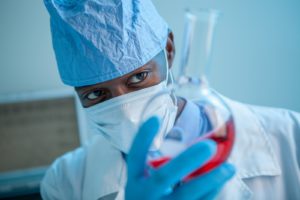
Cryptorchidism, a condition in which one or both testicles fail to descend into the scrotum, presents a unique set of challenges, especially when it comes to male fertility. Treating Cryptorchidism is not only essential for the overall reproductive health, but also holds the potential to address issues related to low sperm count.
Cryptorchidism is a relatively common congenital condition that can affect infants, children, and even adults. The failure of one or both testicles to descend into the scrotum during the developmental stages in infancy can lead to a range of concerns, including an increased risk of testicular cancer, discomfort, and, importantly, fertility issues related to low sperm count.
Source: Risk factors for cryptorchidism
Introduction to Cryptorchidism Treatment
While the causes and mechanisms behind Cryptorchidism can vary, the primary goal of treatment remains consistent: to encourage the descent of the undescended testicle(s) into the scrotum. Achieving this goal not only promotes the normal development of the testes but also has a positive impact on sperm production and quality.
There are various treatment options available for Cryptorchidism and their potential to increase sperm count, ultimately improving male fertility, may be different. They include hormone therapy and surgical intervention, with different effectiveness and benefits in the context of enhancing reproductive health.
Furthermore, it is important to review the timing and considerations involved in Cryptorchidism treatment, underlining the importance of early intervention in cases where low sperm count is a concern. Additionally, there are the potential long-term benefits of successful cryptorchidism treatment, not only in terms of sperm count improvement but also in mitigating the risks associated with this condition.
Hormone Therapy for Cryptorchidism
Hormone therapy represents a valuable treatment approach for Cryptorchidism, particularly in cases where hormonal imbalances are identified as the underlying cause of the condition. Here I will review the details of hormone therapy, its mechanisms, and how it can contribute to the resolution of Cryptorchidism, potentially improving sperm count and fertility.
Hormones in Hormone Therapy
Hormone therapy for Cryptorchidism aims to stimulate testicular descent by addressing hormonal factors that may be preventing the natural descent of one or both testicles into the scrotum. Two primary hormones commonly employed in this treatment are human chorionic gonadotropin (hCG) and gonadotropin-releasing hormone (GnRH).
- Human Chorionic Gonadotropin (hCG): hCG is a hormone that plays a crucial role in stimulating the Leydig cells in the testes to produce testosterone. Testosterone, in turn, promotes the descent of the testicles into the scrotum. In hormone therapy, hCG is administered in specific dosages and schedules to encourage the release of testosterone and facilitate testicular descent. This approach is particularly effective in cases where hormonal deficiencies are identified as a contributing factor to Cryptorchidism.
- Gonadotropin-Releasing Hormone (GnRH): GnRH therapy focuses on addressing hormonal imbalances by directly targeting the hypothalamus, the region of the brain responsible for regulating hormone production. GnRH analogs, synthetic versions of GnRH, are used to stimulate the release of luteinizing hormone (LH) and follicle-stimulating hormone (FSH), both of which play a role in testicular development and function. By optimizing hormonal signaling, GnRH therapy can encourage testicular descent.
While hormone therapy for Cryptorchidism can be effective, its success depends on various factors, including the age of the individual, the cause of the condition, and the specific treatment regimen. It’s important to note that hormone therapy may not always lead to immediate results, and multiple cycles of treatment may be necessary.
Moreover, the potential benefits of hormone therapy extend beyond promoting testicular descent. By addressing the underlying hormonal issues contributing to Cryptorchidism, hormone therapy can also indirectly impact sperm production and quality. As the testicles descend and normalize their function, the likelihood of achieving an increase in sperm count becomes more promising.
Source: Hormonal Treatment of Male Infertility
Hormone therapy represents a valuable treatment option for Cryptorchidism, especially when hormonal imbalances are identified. This approach not only facilitates the descent of undescended testicles but also has the potential to improve sperm count and overall fertility.
Surgical Intervention for Cryptorchidism Treatment
Surgical intervention is a well-established and highly effective treatment approach for Cryptorchidism. This section delves into the details of surgical procedures used to correct Cryptorchidism, namely orchidopexy (orchiopexy) and laparoscopic surgery. We will explore the surgical process, its success rates, and the significant impact it can have on improving sperm count and fertility.
Orchidopexy (Orchiopexy)
Orchidopexy is the most common surgical procedure for treating Cryptorchidism. It involves the surgical fixation of an undescended testicle into the scrotum. The surgeon makes a small incision in the groin or scrotum, locates the undescended testicle, and carefully guides it into the scrotal sac. Once in place, the testicle is secured to prevent it from reascending.
This surgical intervention not only addresses the immediate concern of testicular position but also plays a pivotal role in normalizing testicular function. When the testicle is relocated to the scrotum, it experiences a cooler environment, which is essential for proper sperm production. Over time, this improvement in temperature regulation can lead to an increase in sperm count and quality.
Source: Orchidopexy Surgery
Laparoscopic Surgery
In some cases, especially when the exact location of the undescended testicle is uncertain, laparoscopic surgery may be recommended. Laparoscopic surgery is a minimally invasive procedure that involves making small incisions in the abdomen. A laparoscope, a thin tube with a camera, is inserted through one of these incisions to locate the testicle. Once located, the surgeon can either bring the testicle down into the scrotum or remove it if it is found to be nonviable.
Laparoscopic surgery offers advantages such as smaller incisions, reduced scarring, and shorter recovery times compared to traditional open surgery. It is particularly effective for cases where the testicle’s exact location is difficult to determine.
Source: Undescended Testes and Laparoscopy
Impact on Sperm Count and Fertility
Correcting Cryptorchidism through surgical means, whether through orchidopexy or laparoscopic surgery, provides multiple benefits for fertility. By relocating the testicle(s) to the scrotum, a more favorable temperature environment is established, which supports optimal sperm production. This improvement in temperature regulation can lead to an increase in sperm count and improved sperm quality over time.
Surgical intervention is a highly effective treatment option for Cryptorchidism, offering both immediate benefits in terms of testicular descent and long-term advantages for sperm count and fertility.
Timing and Considerations
The timing of Cryptorchidism treatment is a critical factor, especially when considering the potential to increase sperm count and improve fertility. This section discusses the importance of early intervention, the factors affecting timing, and special considerations related to treating Cryptorchidism.
Early Intervention for Optimal Outcomes
Early intervention is key to achieving the best possible outcomes when treating Cryptorchidism. It is generally recommended to address this condition as early as possible, ideally during infancy or early childhood. The reason for early intervention is twofold:
- Maximizing Testicular Development: By correcting Cryptorchidism early in life, healthcare providers aim to ensure that the affected testicle(s) develop normally. This not only supports the immediate goal of normalizing testicular position but also contributes to long-term testicular health and function.
- Improving Fertility Prospects: Addressing Cryptorchidism in its early stages is crucial for enhancing fertility prospects. Early treatment helps establish the optimal temperature environment within the scrotum, promoting healthy sperm production. This can lead to increased sperm count and better sperm quality when the individual reaches reproductive age.
Factors Affecting Timing
Several factors can influence the timing of Cryptorchidism treatment:
- Age of Diagnosis: The age at which Cryptorchidism is diagnosed plays a significant role in determining the timing of treatment. The earlier the diagnosis, the better the chances of successful correction and improved fertility outcomes.
- Severity of the Condition: The severity of Cryptorchidism can vary. In some cases, the testicle(s) may be partially descended, while in others, they may be entirely undescended. The extent of the condition can impact the choice of treatment and the urgency of intervention.
- Individual Health and Development: The overall health and developmental progress of the individual are important considerations. Some children may require additional time for natural descent, while others may benefit from earlier surgical intervention.
Special Considerations
Special considerations may come into play when treating Cryptorchidism, particularly in cases where associated conditions or complications are present. Healthcare providers will take into account factors such as:
- Bilateral Cryptorchidism: When both testicles are undescended, the treatment approach may be different from for unilateral Cryptorchidism.
- Retractile Testicle: In some instances, what appears to be Cryptorchidism may actually be a retractile testicle, which temporarily moves out of the scrotum. Careful evaluation is necessary to determine the appropriate course of action.
- Underlying Conditions: Certain medical conditions, such as genetic syndromes, may be associated with Cryptorchidism. These underlying conditions may require specialized treatment or monitoring.
The timing of Cryptorchidism treatment is a crucial consideration, as early intervention offers the best chances of normal testicular development, improved fertility, and increased sperm count. Factors such as the age of diagnosis, severity of the condition, and individual health play essential roles in determining when and how treatment is administered.
Source: Cryptorchidism Treatment and Management
By addressing Cryptorchidism promptly and effectively, individuals can pave the way for better reproductive health and fertility outcomes.
Effects of Cryptorchidism Treatment Over Time
Treating Cryptorchidism extends beyond correcting testicular position; it holds the potential to significantly improve sperm count and overall fertility prospects.
Optimizing Temperature Regulation
One of the primary mechanisms by which Cryptorchidism treatment improves sperm count is by normalizing the temperature environment of the testicles. When the testicles are located within the scrotum, they are exposed to a slightly cooler temperature than the rest of the body. This temperature difference is crucial for healthy sperm production. Undescended testicles, which are located in the abdomen or inguinal canal, are exposed to higher temperatures, which can impede sperm production and quality.
Promoting Sperm Production
Correcting Cryptorchidism through surgical means, such as orchidopexy or laparoscopic surgery, relocates the testicle(s) to the scrotum. This surgical intervention not only addresses testicular position but also normalizes the testicular microenvironment. As a result, the Leydig cells in the testes can function optimally, leading to an increase in testosterone production. Adequate testosterone levels support sperm production, which, in turn, contributes to an improvement in sperm count.
Gradual Improvement Over Time
It’s important to note that the increase in sperm count following Cryptorchidism treatment may not be immediate. Sperm production is a continuous process, and it may take several months for the full benefits of treatment to become apparent. Monitoring sperm count through regular semen analysis can provide insights into the progress of improvement.
Fertility Enhancement
The ultimate goal of improving sperm count through Cryptorchidism treatment is to enhance fertility prospects. Individuals who have undergone successful treatment may experience an increased likelihood of natural conception. This can reduce the need for assisted reproductive technologies and offer couples a greater chance of achieving their family planning goals.
Post-Treatment Monitoring
After Cryptorchidism treatment, individuals should continue to undergo regular check-ups and follow-up care with healthcare providers. Monitoring sperm count and overall reproductive health is essential to track progress and make any necessary adjustments to the treatment plan.
Treating Cryptorchidism not only corrects testicular position but also has a profound impact on sperm count and fertility. By optimizing temperature regulation and promoting healthy sperm production, successful treatment paves the way for enhanced reproductive health and improved chances of natural conception. As individuals progress through their journey to better reproductive health, the potential for increased sperm count offers hope and optimism for the future.
Source: Cryptorchidism, Its Impact on Male Fertility
Conclusion: The Benefits of Cryptorchidism Treatment for Increased Sperm Count
In the quest for improved reproductive health, addressing Cryptorchidism, a condition characterized by undescended testicles, emerges as a pivotal step that not only corrects testicular position but also holds the potential for substantial enhancements in sperm count.
- Optimizing Sperm Count: The primary and most significant benefit of Cryptorchidism treatment is its potential to significantly increase sperm count. By relocating the undescended testicle(s) into the scrotum, the treatment normalizes the testicular microenvironment, supporting optimal sperm production. This improvement in sperm count enhances the individual’s chances of achieving natural conception.
- Enhanced Fertility Prospects: As sperm count improves following successful Cryptorchidism treatment, so do fertility prospects. Individuals who have undergone treatment may experience an increased likelihood of natural conception, reducing the need for assisted reproductive technologies. This enhancement in fertility prospects brings optimism and greater control over family planning.
- Long-Term Testicular Health: Treating Cryptorchidism not only addresses immediate concerns but also contributes to long-term testicular health. By ensuring normal testicular development and function, treatment reduces the risk of potential complications, such as testicular cancer, associated with undescended testicles.
- Post-Treatment Monitoring: After Cryptorchidism treatment, it is crucial to continue monitoring sperm count and overall reproductive health. Regular follow-up care with healthcare providers allows individuals to track their progress and make any necessary adjustments to the treatment plan, ensuring the best possible outcomes.
- Improved Quality of Life: Beyond the physiological benefits, Cryptorchidism treatment can lead to an improved quality of life. It alleviates concerns related to testicular position, discomfort, and potential complications, offering individuals peace of mind and confidence in their reproductive health.
Cryptorchidism treatment offers a transformative journey toward increased sperm count and improved reproductive health. By addressing this common condition and its impact on fertility, individuals can unlock the potential for a healthier and more fulfilling family life. The benefits extend beyond mere numbers; they encompass the prospect of building a brighter future with the joys of parenthood, all made possible through the proactive pursuit of Cryptorchidism treatment.


